| Koreans in New York City | |
|---|---|
 Congregating in Manhattan's Koreatown. Congregating in Manhattan's Koreatown.40°44′49″N 73°59′13″W / 40.747°N 73.987°W / 40.747; -73.987 | |
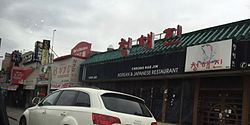
40°44′32″N 73°52′43″W / 40.74221°N 73.87863°W / 40.74221; -73.87863
As of the 2011 American Community Survey, New York City is home to 100,000 ethnic Koreans, with two-thirds living in the borough of Queens. The overall Greater New York combined statistical area enumerated 218,764 Korean American residents as of the 2010 United States Census, the second-largest population of Koreans outside of Korea and the most prominent.
History
Mass Korean immigration to the United States began in the 1950s, with a large wave occurring over the 1960s and 1970s. Koreans historically came to the New York metropolitan area with the intention of permanently settling in the city and establishing businesses. Originally, ethnic Koreans settled in highly urbanized neighborhoods in Manhattan and Queens, but beginning in the 1980s, wealthier Koreans began moving to suburban communities in nearby Bergen County, New Jersey across the George Washington Bridge, alongside the Hudson River—as well as to adjacent Nassau County (on Long Island) and Westchester County, both locally within New York State itself. Many ethnic Koreans moved into areas already settled by the metropolitan Japanese community. By 1988, there were about 150,000 ethnic Koreans living in the New York City area. In the 1980s, a continuous stream of Korean immigrants also emerged into the Long Island Koreatown, many of whom began as employees in the medical field or as Korean international students who had moved to New York City to find or initiate professional or entrepreneurial positions. They established a foothold on Union Street in the Flushing neighborhood of Queens, between 35th and 41st Avenues, featuring restaurants and karaoke (noraebang) bars, grocery markets, education centers and bookstores, banking institutions, offices, consumer electronics vendors, apparel boutiques, and other commercial enterprises. In 1990, Korean-American owned shops were boycotted in the Flatbush section of Brooklyn; the boycott started by Black Nationalist, Sonny Carson, lasted for six months and became known as the Flatbush boycott. In September 2023, Oh Se-hoon, the mayor of Seoul, met with New York City mayor Eric Adams in Manhattan to deepen the cultural and economic ties between Seoul and New York City.
Geographic distribution
Manhattan's Koreatown is primarily a Korean business district in Midtown Manhattan, but since 2008, the district has seen an increase in Korean and European traffic as well, and the resident Korean population in the area has grown concomitantly. There was never a formal plan or agreement to create a Korean commercial district in Manhattan. However, given the high levels of tourist traffic stemming from its proximity to the Empire State Building, Macy's Herald Square, Penn Station, Madison Square Garden, the Garment District, and the Flower District, amongst other Midtown Manhattan landmarks, it was an ideal location for Korean immigrants to settle. Initiated by the opening of a Korean bookstore and a handful of restaurants in the 1980s, Koreatown sprang into being. With their success, an additional stream of Korean-owned businesses took root in the neighborhood, coinciding with increased immigration from Korea; and with rising demand for the prime location, overall property values in the area increased as well. According to the 2010 United States Census, the Korean population of Manhattan (co-extensive with New York County) had nearly doubled to approximately 20,000 over the decade since the 2000 Census. Although Korea Way continues to represent the heart of Koreatown, situated between Broadway, Sixth Avenue, and Fifth Avenue, Koreatown itself has been expanding further eastward from Fifth Avenue along East 32nd Street, toward Park Avenue in Midtown Manhattan, in the direction of Queens. Koreatown, Manhattan has become described as the "Korean Times Square" and has emerged as the international economic outpost for the Korean chaebol. More broadly, Koreatown is attracting new Korean residents to the adjacent Manhattan neighborhoods of Murray Hill, Kips Bay, and Rose Hill. The world's largest international Korean Pride Festival was inaugurated in Koreatown, Manhattan in October 2022 and has been growing on an annual basis.
As the community grew in wealth, population, and socioeconomic status, Koreans expanded their presence eastward along Northern Boulevard, buying homes in more affluent and less crowded Queens neighborhoods and more recently into adjacent suburban Nassau County, bringing their businesses with them, and thereby expanding the Koreatown itself. This expansion has led to the creation of an American Meokjagolmok, or Korean Restaurant Street, around the Long Island Rail Road station in Murray Hill, Queens, exuding the ambience of Seoul itself. The eastward pressure to expand was also created by the inability to move westward, inhibited by the formidable presence of the enormous Flushing Chinatown centered on Main Street. Per the 2010 United States Census, the Korean population of Queens was 64,107, while the Korean population of Nassau County had increased by nearly two-thirds to approximately 14,000 over one decade since the 2000 Census. Korean Air and Asiana Airlines provide non-stop flights from Seoul to JFK Airport in Queens, and the Consulate-General of South Korea in Manhattan has played an important role in mediating travel to and from Korea by the Korean diaspora living in the New York metropolitan area.

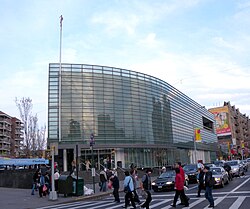
Other established and growing Koreatowns in the New York metropolitan area are located in nearby Bergen County, New Jersey, namely the Fort Lee Koreatown and the Palisades Park Koreatown. Signage in Hangul is ubiquitous in all of the Koreatowns.
Education
Korean language schools in the New York City region tend to have distinct educational missions and clienteles, and each school has its own distinct management. Because, as of 1988, ethnic Koreans settling in New York City generally intended to permanently immigrate to the United States, the only Korean-oriented schools that year were supplementary institutions holding classes on Saturdays and Sundays.
Korean churches typically hold Korean language classes for a half to one hour per week during Sundays. In addition to the churches, there are non-religious operators of Korean schools. In 1988, the Consulate-General of South Korea in New York stated that about 40% of the Korean schools in the New York City area were non-religious. The first Korean schools were established by ethnic Korean churches.
Individual Korean schools
The Korean School of New York was the first secular Korean school established in the city, opening in 1973. The founder, who remained as the school's principal academic administrator in 1988, believed that Korean language education should be separate from religion. As of 1988, this school had 205 students.
The Korean School of Queens originated as a church-operated school, and as of 1988, offered classes for elderly persons and children. In that year, the school had 141 enrolled students. As of 1988, the Korean School of New Jersey (뉴저지 한국학교) had 262 students, making it the largest Korean school in the New York City area, serving students living in suburbs in northern New Jersey. In 1988, the Church of Brooklyn Korean Language School had 120 students, the Broadway Korean School of New York had 97 students, the Westchester Korean School had 50 students, and the Pearl River Korean School had 36 students. In 2014, the McGoldrick Branch of the Queens Library in Flushing began holding Korean language classes.
Korean culture
Korean cuisine
Development of Koreatown, Manhattan as a Korean dining destination
Main article: Koreatown, Manhattan
Approximately fifteen restaurants conduct business 24/7 on Korea Way in Koreatown, Manhattan. Korean restaurants in the district have had to expand or stay open around the clock to meet rising commercial rents and stay financially viable, given the growing prestige and high customer volume generated by foot traffic in Koreatown, Manhattan, and greater investment and involvement by the Korean chaebol. Historically known as a more tourist-oriented alternative to the residential and somewhat suburban Flushing and Murray Hill, Queens in the nearby Long Island Koreatown, Koreatown in Manhattan has since developed a reputation as an authentic Korean dining destination.
Recognition by chefs and authenticity of Korean cuisine in Queens
Main article: Koreatown, Long IslandAccording to The New York Times, a "Kimchi Belt" stretches along Northern Boulevard and the Long Island Rail Road tracks, from Flushing, Queens, eastward into Nassau County, in the Long Island Koreatown. A prominent Korean food chef stated that "Queens is the closest you can come to authentic Korean food." The Long Island Koreatown features numerous restaurants that serve both traditional and/or regional Korean cuisine. The development of this Koreatown has led to the creation of an American Meokjagolmok, or Korean Restaurant Street, around the Long Island Rail Road station in Murray Hill, Queens, exuding the ambience of Seoul itself. Korean Chinese cuisine is also available in the Long Island Koreatown.
Koreatowns in Bergen County, New Jersey

Broad Avenue in Koreatown, Palisades Park in Bergen County, New Jersey has been referred to as the "Korean food walk of fame", with diverse offerings. Palisades Park's Koreatown now incorporates the highest concentration of Korean restaurants within a one-mile radius in the United States, and Broad Avenue has evolved into a Korean dessert destination as well. Korean Chinese cuisine is now also available in Koreatown, as is misugaru. Bulgogi and galbi are staples on Broad Avenue in the Palisades Park Koreatown. Korean cafés have become a major cultural element within Palisades Park's Koreatown, not only for the coffee, bingsu (shaved ice), and pastries, but also as communal gathering places. Koreatown in Palisades Park, and its adjacently connected Koreatown in Fort Lee, New Jersey, have emerged as a dominant nexus of Korean American culture.
K-Pop
The K-Pop industry is active in New York City, hosting numerous concerts in the city as well as being home to K-Pop musicians. The musical KPOP opened Off-Broadway in 2017 and moved to Broadway in 2022, with Luna in the starring role, and co-starring fellow K-pop stars Kevin Woo, Min-Young Lee, and Kim Bo-hyung (김보형).
Notable people
- Korean New Yorkers
-
 David Chang
David Chang
-
 Juju Chang
Juju Chang
-
 Liz Cho
Liz Cho
-
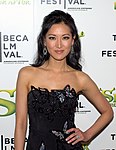 Kelly Choi
Kelly Choi
-
 Susan Choi
Susan Choi
-
 Judy Joo
Judy Joo
-
 Irene Kim
Irene Kim
-
 Joel Kim Booster
Joel Kim Booster
-
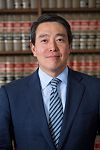 Joon Kim
Joon Kim
-
 Ron Kim
Ron Kim
-
 Andrew Kwon
Andrew Kwon
-
 Luna
Luna
-
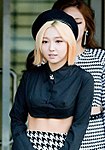 Min
Min
-
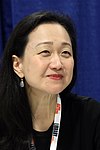 Min Jin Lee
Min Jin Lee
-
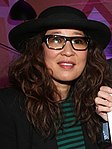 Sandra Oh
Sandra Oh
-
 Ashley Park
Ashley Park
-
 Kevin Woo
Kevin Woo
- Awkwafina – actress, rapper
- Joel Kim Booster – actor
- Richard Chai – fashion designer
- David Chang – international restaurateur
- Ronnie Cho – political consultant
- Jun Choi – former mayor of Edison, New Jersey
- Kyung Hee Choi – Vice President, Asian Health Services and Korean Medical Program (한국인의 의료 프로그램), Holy Name Medical Center, Teaneck, Bergen County, New Jersey
- MeeYoung Choi – Chief of North America and Korea, Transport Capital
- Susan Choi – novelist
- Alton Chun – executive manager, five-star luxury Hotel Park Hyatt New York in Midtown Manhattan
- Christopher Chung – the first elected mayor of Bergen County's Palisades Park, where Koreans constitute the majority of the population
- Bill Hwang – Wall Street investor in Tenafly in Bergen County, New Jersey
- Saeju Jeong – CEO, health fitness app Noom
- Susan Kang – associate professor of political science, John Jay College of Criminal Justice
- Gina Kim – borough clerk, Palisades Park, Bergen County, New Jersey
- Jean Kim – political lobbyist
- Joon Kim – acting United States Attorney for the Southern District of New York, 2017–2018
- Judy Kim – Manhattan state Supreme Court judge
- Kevin D. Kim – Commissioner, New York City Department of Small Business Services (SBS)
- Kyung Kim – chief operating officer, KFF Inc., parent company of Dons Bogam Korean barbeque restaurants in the New York metropolitan area
- Ron Kim – member of the New York State Assembly, representing the 40th District, including Whitestone, Flushing, College Point, and Murray Hill in Queens
- Andrew Kwon – fashion designer
- Grace Lee – member of the New York State Assembly, representing the 65th District in Lower Manhattan, elected in November 2022
- Joo-Yung Lee – managing director, North American financial institutions, Fitch Ratings
- Carol Lim – fashion designer
- Luna – singer-songwriter and Broadway actress
- Min – singer-songwriter and Broadway actress
- Ashley Park – Broadway actress, dancer, and singer
- Ellen Park – member of the New Jersey State Assembly, representing Bergen County's 37th District, elected in November 2021
- Helen Park – composer and songwriter
- Jae Shin – actor
- Julie Won – councilwoman, New York City's 26th district in western Queens, elected in November 2021
- Kevin Woo – singer-songwriter, Broadway actor, and television host
- Rob Yang – actor
- Kyung Yoon – President and CEO, Korean American Community Foundation
- Michael Yun – councilman, Jersey City, elected in 2013
Media
See also: New Yorkers in journalism and Media in New York CityKorean people have emerged prominently in the New York City journalism sphere. This media subsection has been created to acknowledge this professional prominence.
- Juju Chang – journalist, ABC News, anchor of Nightline
- Katie Chang – journalist, Food and Wine
- Sophia Chang – journalist, Gothamist and WNYC public radio
- Elizabeth Cho (disambiguate) – journalist, Bracha
- Liz Cho (disambiguate) – news anchor, WABC-TV
- Ann Choi – senior inestigative reporter, Bloomberg Businessweek
- Kelly Choi – anchor for NYC Media, the official public radio, television, and online media network and broadcasting service of the City of New York, and host of Secrets of New York
- Kay Chun – cooking editor, The New York Times
- Christine Chung – travel journalist, The New York Times
- Euny Hong – journalist, author of Birth of Korean Cool: How One Nation is Conquering the World Through Pop Culture (2014), which has been published in seven languages
- Jimmy Im – senior lifestyle writer, CNBC
- Judy Joo – chef and television personality
- Jay Caspian Kang – The New York Times Magazine
- Susan Kang – New York Daily News
- Allen Kim – digital producer, culture and trends, CNN
- CeFaan Kim – journalist, WABC-TV
- Elizabeth Kim – Gothamist
- Eric Kim – food columnist, The New York Times
- Eugene Kim – CNBC
- Jasmine Kim – digital content journalist, CNBC
- Hakyung Kim – CNBC
- Irene Kim – fashion journalist and fashion model
- Michelle J. Kim – journalist and digital content producer, WNBC-TV
- Richard Kim – editor-in-chief, THE CITY
- Tae Kim – investing journalist, CNBC
- Kim Ye-rin – The Korea Herald
- Genevieve Ko – senior food editor, The New York Times
- Chang W. Lee – photojournalist, The New York Times
- Edmund Lee – journalist, The New York Times
- Karen Lee – weekend television anchor, News 12 New Jersey
- Min Jin Lee – author journalist
- MJ Lee – journalist, CNN
- Yeji Jesse Lee – journalist, Business Insider
- Jeenah Moon – photojournalist, The New York Times
- Christina Park – journalist
- Ishle Yi Park – first female poet laureate of Queens, from 2004 to 2007
- Hannah Seo – journalist, The New York Times
- Hugh Son – journalist, CNBC
- Elisa Ung – award-winning food writer and restaurant critic
- Janice Yu – journalist, WABC-TV Eyewitness News
See also
- Koreatown, Fort Lee
- Koreatown, Palisades Park
- Asian Americans in New York City
- Bangladeshis in New York City
- Chinese people in New York City
- Demographics of New York City
- Filipinos in the New York metropolitan area
- Fuzhounese in New York City
- Indians in the New York City metropolitan region
- Japanese in New York City
- Russians in New York City
- Taiwanese people in New York City
Notes
- (in English) Kunieda, Mari (國枝 マリ; School of International Cultural Relations). "Assimilation to American Life vs.Maintenance of Mother Culture : Japanese and Korean Children in New York" (Archive; Japanese title: 異文化接触と母国文化 : 在ニューヨーク日本人・韓国人子女の場合). Hokkaido Tokai University Bulletin (北海道東海大学紀要): Humanities and social sciences (人文社会科学系) 1, 131–147, 1988. Hokkaido Tokai University. See profile at CiNii. Abstract in Japanese available.
- Min, Pyong Gap and Young I. Song. "Demographic Characteristics and Trends of Post-1965 Korean Immigrant Women and Men" (Chapter 5). In: Song, Young In and Ailee Moon (editors). Korean American Women: From Tradition to Modern Feminism. Greenwood Publishing Group, January 1, 1998. Start page 45. ISBN 0275959775, 9780275959777.
References
- ^ Asian Americans: Contemporary Trends and Issues Second Edition, Edited by Pyong Gap Min. Pine Forge Press – An Imprint of Sage Publications, Inc. 2006. ISBN 9781412905565. Retrieved February 6, 2014.
- ^ Kirk Semple (June 8, 2013). "City's Newest Immigrant Enclaves, From Little Guyana to Meokjagolmok". The New York Times. Retrieved February 6, 2014.
- ^ John Roleke. "Flushing: Queens Neighborhood Profile". About.com. Retrieved February 6, 2014.
- "Koreatown Manhattan, or Koreatown Flushing?". CBS Interactive Inc. June 2009. Retrieved February 6, 2014.
- ^ Joyce Cohen (March 23, 2003). "If You're Thinking of Living In/Murray Hill, Queens; The Name's the Same, the Pace is Slower". The New York Times. Retrieved February 6, 2014.
- "ACS DEMOGRAPHIC AND HOUSING ESTIMATES more information 2011 American Community Survey 1-Year Estimates, Geographies New York City, New York and Queens County, New York". Archived from the original on February 12, 2020. Retrieved February 6, 2014.
- "Profile of General Population and Housing Characteristics: 2010 Demographic Profile Data New York-Newark-Bridgeport, NY-NJ-CT-PA CSA". U.S. Census Bureau. Archived from the original on February 12, 2020. Retrieved February 6, 2014.
- Chi-Hoon Kim (2015). Savoring Gotham: A Food Lover's Companion to New York City: A Food Lover's... Oxford University Press. ISBN 9780190263638. Retrieved October 11, 2015.
- Kunieda, p. 133.
- "Mayor Oh Se-hoon visits the New York Korean War Veterans Memorial". Seoul Metropolitan Government. September 21, 2023. Retrieved September 23, 2023.
- ^ Baldwin, Deborah (October 17, 2008). "Living In Koreatown Exotic Flavor, Beyond Just the Food". The New York Times. Retrieved February 6, 2014.
- "New York County, New York QuickLinks". U.S. Census Bureau. Archived from the original on June 19, 2013. Retrieved February 6, 2014.
- Gina Pace (April 26, 2015). "Koreatown in NYC is now being taken more seriously as a dining destination". New York Daily News. Retrieved March 6, 2018.
Koreatown — long centered on 32nd St. between Fifth and Sixth Aves., nicknamed Korea Way — has expanded in recent months. The new Baekjeong spot, for example, is located just east of Fifth Ave...Kihyun Lee took an even bigger gamble by opening a dual-concept spot midblock on 31st St. between Fifth and Madison Aves...
- Shinhan Bank America Accessed March 6, 2018.
- Don's Bogam Korean restaurant Accessed March 6, 2017.
- ^ Sam Kim, photography by Gary He (July 31, 2018). "NYC's K-Town Isn't What It Used to Be". Vox Media. Retrieved November 22, 2018.
Most mom-and-pops are gone, and 32nd Street is now dominated by chains due to high rents and policies in Korea itself.
- "Queens County, New York QuickLinks". U.S. Census Bureau. Archived from the original on February 25, 2016. Retrieved February 6, 2014.
- "Nassau County, New York QuickLinks". U.S. Census Bureau. Retrieved February 6, 2014.
- Matt Molnar (August 9, 2011). "New Korean Air Airbus A380 Makes First Flight to America". Copyright 2012 NYCAviation All Rights Reserved. Retrieved February 6, 2014.
- "Flights from New York to Seoul". 2011 Expedia, Inc. All rights reserved. Retrieved February 6, 2014.
- ^ Kunieda, p. 137.
- Kunieda, p. 136-137.
- ^ Kunieda, p. 147.
- "Queens library launches its first Korean language school" (Archive). Korea Times. October 10, 2014. Retrieved on April 10, 2015.
- ^ Feldman, Zachary (November 26, 2010). "In The Midnight Hour: BCD Tofu House in Koreatown". Retrieved February 27, 2018.
- ^ Gina Pace (April 26, 2015). "Koreatown in NYC is now being taken more seriously as a dining destination". New York Daily News. Retrieved February 27, 2018.
Koreatown — long centered on 32nd St. between Fifth and Sixth Aves., nicknamed Korea Way — has expanded in recent months. The new Baekjeong spot, for example, is located just east of Fifth Ave...Kihyun Lee took an even bigger gamble by opening a dual-concept spot midblock on 31st St. between Fifth and Madison Aves...
- ^ Pete Wells (December 16, 2014). "In Queens, Kimchi Is Just the Start – Pete Wells Explores Korean Restaurants in Queens". The New York Times. Retrieved February 27, 2018.
- "Palisades Park, NJ: K-Town West of Hudson". WordPress.com. June 11, 2007. Retrieved September 24, 2011.
- Elisa Ung (February 9, 2014). "Ung: Destination spot for desserts". North Jersey Media Group. Retrieved February 9, 2014.
- Elisa Ung (June 12, 2014). "Five Korean dishes to try this summer". North Jersey Media Group. Retrieved June 12, 2014.
- Joan Verdon (June 5, 2014). "Korean coffee chain expanding in North Jersey". North Jersey Media Group. Retrieved June 6, 2014.
- Katie Sobko (February 10, 2018). "Sweet treats and caffeine, with twist". northjersey.com - part of the USA TODAY network. Retrieved February 11, 2018.
- "Former Obama staffer enters race for New York City Council". NBC News. March 21, 2017. Retrieved August 3, 2023.
- "Korean Medical Program". Holy Name Medical Center, Teaneck, Bergen County, New Jersey. Retrieved July 26, 2018.
- "MeeYoung Choi". transportcapital.com. May 18, 2021. Retrieved June 13, 2022.
- travelpulse Accessed July 31, 2018.
- Kristie Cattafi (January 3, 2019). "Palisades Park makes history in Bergen County, swears in first Korean-American mayor". NorthJersey.com – part of the USA TODAY network. Retrieved January 31, 2019.
- "10 Things You Didn't Know About Saeju Jeong". moneyinc.com. June 13, 2021. Retrieved July 5, 2022.
- cuny Accessed December 11, 2020.
- northjersey.com Accessed August 14, 2021.
- nytimes Accessed May 4, 2021.
- Elizabeth Rosner, Priscilla DeGregory and Bruce Golding (February 11, 2022). "NYC unsure how many workers will be fired over vax refusal: Eric Adams". New York Post. Retrieved February 11, 2022.
- "Mayor Adams Celebrates new All-Time High Total Jobs Record, Announces $85 Million Delivered to Small Businesses Through Groundbreaking Opportunity Fund". City of New York. March 11, 2024. Retrieved July 17, 2024.
New York City Mayor Eric Adams and New York City Department of Small Business Services (SBS) Commissioner Kevin D. Kim today celebrated that New York City has set another all-time high for the total number of jobs ever in the city's history, with 4,730,066 total jobs, according to new data released by the New York State Department of Labor.
- jerseydigs Accessed March 14, 2019.
- nj.com Accessed March 14, 2019.
- Strauss, Alix (October 5, 2021). "Dressing Brides for 'Their Red-Carpet Moment'". The New York Times.
- linkedin Accessed April 12, 2018.
- northjersey Accessed November 3, 2021.
- Kennedy, Lisa (May 3, 2022). "'In a New York Minute' Review: Love or Freedom?". The New York Times. Retrieved May 5, 2022.
- "Korean American Community Foundation Staff". Korean American Community Foundation. Retrieved May 28, 2024.
- "WARD D (THE HEIGHTS) COUNCILMAN MICHAEL YUN". City of Jersey City. Retrieved June 28, 2018.
- "Katie Chang Location: Brooklyn, New York". Food and Wine. Retrieved April 3, 2024.
- gothamist.com gothamist Accessed December 21, 2020.
- wnyc Accessed December 21, 2020.
- "Why NYC continues to be a "safe haven" for global real estate investors — Ilan Bracha – NYC Real Estate". www.bracha.com. August 9, 2019. Retrieved May 31, 2022.
- Donnan, Shawn; Choi, Ann; Levitt, Hannah; Cannon, Christopher. "Wells Fargo Rejected Half Its Black Applicants in Mortgage Refinancing Boom". Bloomberg.com. Retrieved March 14, 2022.
- nytimes Accessed July 5, 2021.
- "Christine Chung moving to Travel". The New York Times. March 15, 2023. Retrieved May 25, 2024.
- cnbc Accessed September 28, 2018.
- "Susan Kang". Muck Rack. Retrieved March 25, 2023.
- cnn Accessed May 11, 2020.
- "CEFAAN KIM". WABC-TV New York. Retrieved April 18, 2018.
- gothamist Accessed December 21, 2020.
- "Eric Kim – the New York Times". www.nytimes.com. Retrieved June 15, 2022.
- cnbc Accessed February 14, 2019.
- cnbc Accessed May 14, 2020.
- "Hakyung Kim". CNBC. Retrieved July 9, 2023.
- nbc Accessed May 20, 2020.
- "Richard Kim Joins New York News Start-Up "THE CITY" As Editor In Chief". THE CITY. January 4, 2022. Retrieved August 22, 2023.
- cnbc Accessed August 9, 2018.
- "[Photo News] 'Fashion's biggest night out'". m.koreaherald.com. September 17, 2021. Retrieved March 25, 2022.
- Sam Sifton, Emily Weinstein, and Patrick Farrell (October 6, 2020). "Genevieve Ko Joins Food and NYT Cooking". The New York Times. Retrieved November 16, 2020.
{{cite news}}: CS1 maint: multiple names: authors list (link) - nytimes Accessed November 28, 2020.
- edmundlee Accessed May 5, 2021.
- nytimes Accessed May 5, 2021.
- news12 Accessed September 12, 2018.
- "CNN Profiles – MJ Lee – Correspondent". CNN. Retrieved April 5, 2019.
- linkedin Accessed April 22, 2020.
- lensculture Accessed March 11, 2019.
- nytimes Accessed March 11, 2019.
- "Ishle Yi Park". www.poetryfoundation.org. Retrieved August 3, 2023.
- "Hannah Seo". The New York Times. Retrieved August 9, 2022.
- Chris Roush (April 10, 2018). "Bloomberg's Son hired by CNBC to cover banks". Talking Biz News. Retrieved May 3, 2018.
- elisaung.com Accessed July 26, 2018.
- "Janice Yu". Eyewitness News. Retrieved December 9, 2024.
Further reading
- Kim, Claire Jean. Bitter Fruit: The Politics of Black-Korean Conflict in New York City. Yale University Press, February 1, 2003. ISBN 0300093306, 9780300093308.
- Kim, Jongyun. Adjustment Problems Among Korean Elderly Immigrants in New York and Los Angeles and Effects of Resources on Psychological Distress and Status in the Family (dissertation). ProQuest, 2008. ISBN 0549566058, 9780549566052. UMI Number 3307607.
- Min, Pyong Gap. Ethnic Solidarity for Economic Survival: Korean Greengrocers in New York City. Russell Sage Foundation, April 3, 2008. ISBN 1610443985, 9781610443982.
External links
- (in Korean) The Korean School of New Jersey
| Korean diaspora | |||||||||
|---|---|---|---|---|---|---|---|---|---|
| Africa | |||||||||
| North America | |||||||||
| South America | |||||||||
| Asia |
| ||||||||
| Europe |
| ||||||||
| Oceania | |||||||||
| Related topics |
| ||||||||